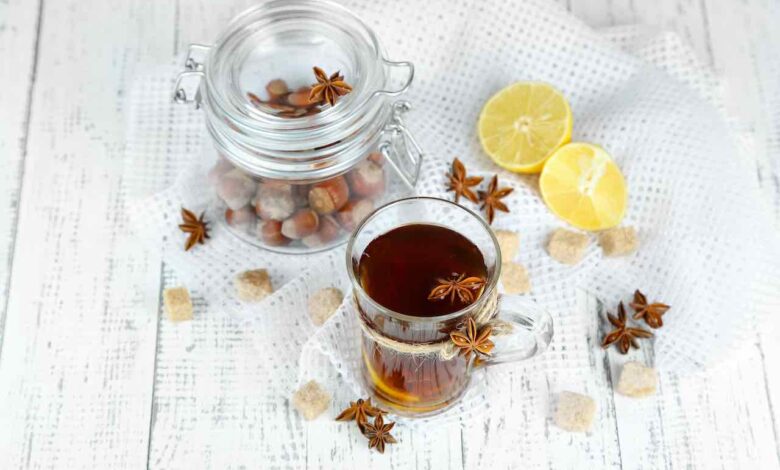Hello, Sweet Willow friend!
Keep spring allergies at bay with Anise tea

By T. Heather Herdman, PhD, RN, FAAN
Spring is nearly here — can you feel the difference in the warmth of the sun? In the way the birds are singing? In the stirring of our perennial green friends? This is a time of anticipation, and I often find myself feeling like a kid at Christmas time — when do I get to open the packages? Only for me, it is the seed packages! So I content myself with transplanting seedlings into larger containers — and hold myself back from rushing outdoors to stick my hands in the dirt (which I know is still too cold) and directly seeding into my garden! It often feels so long to get from early spring to planting season. And we are bound to still have cold weather, the last vestiges of winter in the form of snow and sleet. But I take heart that it won’t last long, that soon I will sit outdoors and enjoy the warmth of the sun as I drink my morning coffee, and my dog walks will become longer and more frequent as I look to see what’s peaking out of the ground, and what winged creatures are returning to nest. In the interim, I try to find a moment in the day to go stand outside and soak up a little sun (Vitamin D), and daydream about the summer to come.
Farmer Donna and I have been working with local farmers to set a schedule for what herbs she and they will grow for us, as we aim to bring our local sourcing of herbs to a much higher percentage this year. We will have plants for you again this year in the store, started here by local farmers and herbalists, using organic principles and non-GMO seeds.
And, we have some things to help you try to enjoy this season of anticipation, including classes and new herbal tea blends. Finally, as a reminder to those of you who suffer from seasonal allergies, it’s a good time to start using our Aaaa-Choo! herbal tea blend. It works best when you start before the allergens are at peak, and continue using throughout the allergy season.
How to keep your spring allergies at bay
When we think about seasonal allergies, we generally point our finger at a plant or tree. Although these may be part of the problem, we also need to consider what else we could be doing to put our bodies in the best situation to fight off the results of the allergen. We can start with anti-inflammatory diets; include fermented foods to support good gut bacteria, get sufficient sleep, and go outside to soak up some sun, because a lack of Vitamin D has been correlated to a higher allergy response. I think it is “the American way” to want to reach for a pill — or an herb — to “fix” the problem (allergies, in this case) — but we have to think about our whole being, our behaviors if we really want the best results.
There are several herbs that I immediately consider when someone approaches me about dealing with allergies. My first is always stinging nettle (Urtica dioica), which decreases inflammation and histamine release that accompanies allergies, which I have mentioned many times before. In a randomized, double-blind study, people who were identified to have allergies reported fewer symptoms after one week of freeze-dried nettle (Mittman, 1990).
However, today I want to focus on the anise seed (Pimpinella anisum L.). Studies have shown anise seeds (and essential oil) have properties that are antioxidant, antibacterial, antifungal, anti-inflammatory, analgesic, gastro-protective, and antiviral activities, as well as a lot of others! Anise seeds contain many essential B-complex vitamins, vitamin A and C, and are also an important source of minerals such as calcium, copper, potassium, iron, manganese, magnesium, and zinc. It is possible that its ability to suppress inflammatory responses, and its antispasmodic, bronchodilator, and expectorant actions are most supportive for seasonal allergies.
Anise belongs to the Apiaceae or Umbelliferae plant family, so it is related to other culinary plants such as celery, carrot, caraway, fennel, and dill. As a result, anise seeds can be added to baked goods, fruit fillings for pies, and ground meat before cooking or baking. If adding to pie dough, add between 1/2 teaspoon to one tablespoon of seeds into the dry ingredients before forming the dough. Anise extract can be used in baked goods and to flavor drinks such as coffee or hot chocolate. You often see anise seeds paired with cooked carrots, or with citrus.
We incorporate anise seed (and nettle, of course) into our Aaaa-Choo! herbal tea formula to support you with your seasonal allergies.
Anise tea
For a simple anise seed tea, I like to use organic, whole seeds, which I crush with the back of a spoon to release more oil. Use about 1 TBS per 8 ounces of hot water. Because this is a seed, I like to simmer it on low heat for about 10 minutes, with a lid on the pot, then turn off the heat and let it steep, covered, for another 10 minutes. Strain, add a little honey to taste, and enjoy. I also like to add fresh ginger root to the pot — you’ll have to decide your heat tolerance, but I love ginger, so I use about 1 tsp fresh grated ginger per cup.
Herbal tea blends
The March equinox — also called the vernal equinox, Ostara, or Alban Eilir — marks the beginning of the spring season here in the Northern Hemisphere, and this holiday is the second of three spring celebrations (the midpoint between Imbolc and Beltane), during which light and darkness are again in balance, with the light on the rise. It is a time of new beginnings and of life emerging further from the grips of winter. Because this season represents newness — new growth, new baby winged creatures and four-leggeds — we’ve discovered a combination of herbal blends to encapsulate these feelings of spring as well.
The first blend is called Crane Berry Apple, and it is a new daily blend in which I incorporated freeze-dried Wisconsin apples (from our friends at Theys Orchard) and cranberries from Pip’s Cranberries (Phillips, WI). Did you know that cranberries are Wisconsin’s top export? First harvested in 1860, they were first known as Crane Berries, because the blossoms resemble Sandhill Cranes. Nifty, eh? We paired these with delicious Sweet RiverBelle apples, which are similar in taste and texture to Honeycrisp, but they ripen a little earlier in the season. Sweet RiverBelle apples only thrive in the unique growing climate of the midwest.
The second blend is designed to help wake up our sometimes sluggish digestive system, as it became accustomed to heavier foods during the winter. Roots of Fire Digestif. This tea can provide a kickstart to counteract all the comfort food, inactivity, or even the doldrums holding you down. This blend of roots and spices is just the spark to help you enjoy a new you.
T. Heather Herdman, PhD, RN, FAAN is a nurse, clinical herbalist and aromatherapist, who believes that a combination of traditional (herbalist, for example) and allopathic (Western) health care practices provide the strongest possibilities for health and well-being. She is the owner of Sweet Willow Wellness and Sweet Willow Herbal Co-op (De Pere). She holds nursing masters and doctoral degrees from Boston College, and an undergraduate degree from University of South Carolina. She has authored numerous publications in peer reviewed journals, and her academic interests include clinical reasoning, spirituality, cultural health care practices, and integrative heath care. Heather provides clinical herbal consults and custom blend herbal products for clients. Contact Sweet Willow Wellness at: 920-632-4696, www.SweetWillowWellness.com, Facebook: www.facebook.com/SweetWillowWellness, Instagram: @sweetwillowwellness
Address: 327 Main Ave., Ste B, West DePere.
References: Dargahi, T., Ilkhani, R., Ghiaee, A., Arbabtafti, R., Fahimi, S., Jafari, F., … & Choopani, R. (2021). Anti-inflammatory effect of Pimpinella anisum extract in a mouse model of allergic asthma. Research Journal of Pharmacognosy, 8(3), 41-49.
Haggag, E.G., Abou-Moustafa, M.A., Boucher, W. & Theoharides, T.C. (2003) The effect of a herbal water-extract on histamine release from mast cells and on allergic asthma, Journal of Herbal Pharmacotherapy, 3:4, 41-54, DOI: 10.1080/J157v03n04_03
Mittman, P. (1990). Randomized, double-blind study of freeze-dried Urtica dioica in the treatment of allergic rhinitis. Planta Med., 56(1):44-7. doi: 10.1055/s-2006-960881. PMID: 2192379.
Nasır, A. & Yabalak, E. (2021) Investigation of antioxidant, antibacterial, antiviral, chemical composition, and traditional medicinal properties of the extracts and essential oils of the Pimpinella species from a broad perspective: a review. Journal of Essential Oil Research 33:5, pages 411-426.
Sun, W., Shahrajabian, M.H., & Cheng, Q. (2019) Anise (Pimpinella anisum L.), a dominant spice and traditional medicinal herb for both food and medicinal purposes, Cogent Biology, 5:1, DOI: 10.1080/23312025.2019.1673688




